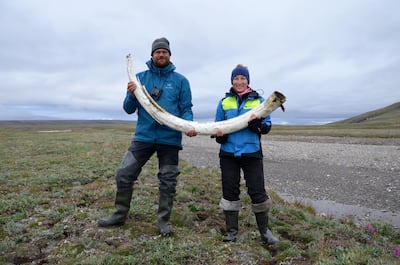Researchers pieced together the world's oldest DNA sample dating back more than a million years, in a discovery that casts new light on how mammoths spread around much of the globe before becoming extinct about 4,000 years ago.
An international team from the Centre for Palaeogenetics in Stockholm pieced together billions of degraded fragments of DNA from mammoth molars – an exercise likened to a massive jigsaw puzzle – to identify three animals, ranging from 700,000 years old to about 1.2 million years old.
The previous oldest DNA sequencing was in 2013 from a horse that lived about 780,000 years ago.
The oldest DNA sample from the three mammoths, reported in the journal Nature, was from the tooth of a previously unknown species named Krestovka, after the area where it was found in Siberia, Russia.
At 1.2 million years old, it predates the better-known woolly mammoth by about 500,000 years.
The Krestovka mammoth was unlike the only other known species in the area at the time and was from a completely different genetic strand to the one that eventually resulted in the woolly mammoth, palaeontologists said.
“This came as a complete surprise to us,” said the study’s lead author Tom van der Valk. “All previous studies have indicated that there was only one species of mammoth in Siberia at that point in time, called the steppe mammoth.
"But our DNA analyses now show that there were two different genetic lineages.”
The team believe that it was this species of mammoth that colonised North America about 1.5 million years ago.
It bred with a woolly mammoth that arrived in the region nearly a million years later to become a "Columbian" hybrid that was found in what would now be Costa Rica, North America, Mexico and Colombia, before becoming extinct 12,000 years ago.
"This is an important discovery. It appears that the Columbian mammoth evolved through a hybridisation that took place approximately 420,000 years ago," said co-lead author Patrícia Pecnerova.
The complex DNA sequencing also casts light on the evolution of the mammoth during a critical period in the history of the Earth about a million years ago when a large number of new species emerged during a period of rapid climate shifts.
The molars were discovered in the 1970s in different parts of Siberia by Andrei Sher, a renowned Russian mammoth expert who died in 2008. They had been stored at the Geological Institute at the Russian Academy of Sciences in Moscow.
The highly-degraded state of the DNA meant that scientists believe that they are the current limits of ability to decode life.
However, DNA could in theory be extracted from samples of up to 2.6 million years old, in situations where when they would have been protected by permafrost.
Climate change has led to the Arctic warming twice as fast as the global average, leading to the discovery of more fossils.
Scientists said there has been a surge in the past decade of Russians mining the permafrost for tusks to sell, mainly to China to make ornaments.
Why mammoths eventually disappeared is unknown. They were thought to be widespread, with large populations until 10,000 years ago.
They survived for another 6,000 years on the Russian Arctic island of Wrangel and researchers are investigating whether inter-breeding led to their ultimate demise.



